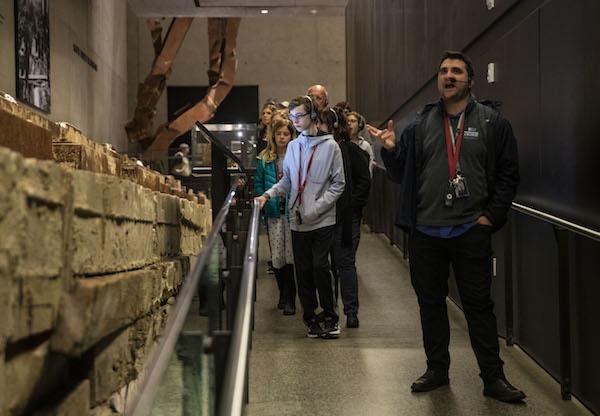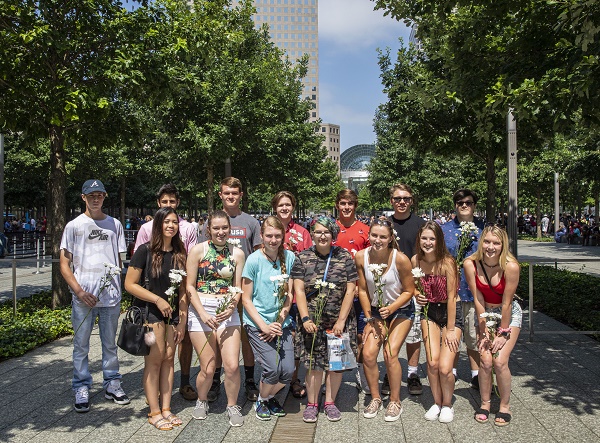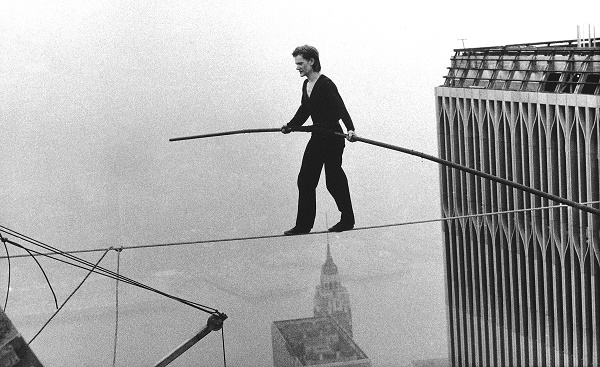Make a donation to the museum
An Interpretive Guide Shares How an Early Access Museum Tour Fosters a Special Experience at the 9/11 Memorial Museum
An Interpretive Guide Shares How an Early Access Museum Tour Fosters a Special Experience at the 9/11 Memorial Museum

The 9/11 Memorial & Museum’s Early Access Museum Tour gives visitors the opportunity to explore the Museum before it opens to the public. This 60-minute tour examines monumental artifacts and tells the stories of those affected by the attacks.
Beau Wilson, a senior museum interpretive guide at the 9/11 Memorial & Museum, sat down to tell us about his experience leading this intimate morning tour of the museum space.
Beau, how did you become interested in working at the 9/11 Memorial & Museum?
My birthday is September 11, I turned 11 years old on 9/11. As a preteen, I struggled with my birthday a bit because I didn’t know how to celebrate on a day that’s very solemn. I didn’t know if that was disrespectful or rude. When people would ask me about my birthday, I would never get a “Happy birthday!” I’d get a “Oh, I’m sorry.” I didn’t like the way that felt. I became interested in working at the 9/11 Memorial & Museum because I had to find a way growing up to get over that.
So this day, September 11, shaped my life in a way. I had to figure out that if I go and I celebrate that day in my own personal way, it doesn’t make me a bad person. I’m not rude or selfish. Working here helped me better understand that it’s okay to move forward, it’s okay to heal. It’s okay not to think about this every day. In a way, getting closer to the day helped me get further away from it.
What sets the Early Access Museum Tour apart from our other tour offerings?
The main benefit is that it takes place before the Museum opens. You’re entering the museum 30 to 45 minutes before anyone from the general public is allowed inside. Not only are you in the Museum at a time no one else is there, but you also have a personal guide leading you through this hallowed space. You are not being distracted by anyone else or their experience. It is just you, the rest of your group and the guide. Because of the “early access” element, you can really form your own experience. That by itself is very special.
In addition to being there by yourselves, you also get to see the Museum get prepared for the day. You get to see people work on artifacts, people in spots you’re not supposed to see people. It’s a behind-the-scenes experience. While, yes, it is similar information that you can get on one of our regular tours, the ambiance around you during the Early Access Museum Tour is different. It’s a lot quieter and more solemn, you’ll see people cleaning artifacts, you’ll see people setting up, you’ll feel like this is just for you in that moment.
As the tour gets to the halfway point, the Museum will open and people will begin coming inside. However, you’re deep enough into the museum space that other visitors won’t have reached yet. By the end of the tour, you will have seen two-thirds of the Museum, and you have an overall idea of the Museum’s exhibitions. You have a much easier time navigating the space, and when your tour ends, you can enter the historical exhibition right when it opens. After you finish your experience in the exhibitions, you know where to go next. The tour gives you a leg up in your experience. While other visitors arriving at 9 a.m. are just figuring out the museum space, you already know where to go and how to get there.
Lastly, you have the opportunity to walk through the space with the guide who has their own perspective about the benefits of the Early Access Museum Tour. During this tour, the guide does not need to worry about giving other visitors directions or sharing the space with crowds. This frees up the guide to create a more dynamic dialogue with their group during the program. The guide only needs to worry about providing an engaging experience to the people on their tour. The tour becomes more tailored to each group of visitors during the Early Access Museum Tour.
What are the stories that you like to highlight during the Early Access Museum Tour?
There are a couple of artifacts that stick out because they have individual stories attached to them, and there are a couple that stick out because of their physicality. For instance, in Center Passage there are three artifacts there that I use to tell individuals’ stories. I tell the story of Steven Jacobson at the Antenna, I tell the story of Jan Demczur at the Elevator Motor, and I tell the story of Captain Paddy Brown at the Ladder Company 3 fire truck. Attaching stories to these artifacts takes these stationary objects made of metal and steel and gives them a human element. These objects represent real people who were here and experienced the attacks firsthand. Some of these people made it, some didn’t make it, but whether you made it or not, your story is important. These artifacts help give me an entry point to these people’s stories.
Tell us a particularly memorable encounter that you had on the tour.
The most memorable experience I’ve had came after I presented Captain Paddy Brown’s story to about 12 people at the Ladder Company 3 fire truck. I was by the back side of the fire truck, talking about Paddy Brown and his role on the day. A woman who was not on my tour came up to me as I was walking to the next artifact. She approached me and said she was a first cousin of Captain Brown and she wanted me to know that the story I just told was beautiful. She wasn’t on my tour, she didn’t take the tour, she just overheard me telling Captain Brown’s story. Her coming up to me to tell me that confirmed that this is good, what I’m doing here. She did it in a way that no one else on my tour heard her, just me. That one always sticks with me a bit.
I’ve had family members on tours, I’ve given tours to ambassadors, admirals of the British Navy—you never know where the visitors are coming from. All our visitors are from different walks of life and have different back stories. At the end of our tour, I often allow five minutes for people to come and share with me if they feel inclined. I’ve heard so many people tell me their story. You never know what it’s going to be, but all visitors remember everything so vividly—what they were doing, where they were, who they were talking to, and yet most of them couldn’t tell you what they had for breakfast today.
September 11 is a flashbulb moment, you know exactly where you were on that morning. People come to the Museum and want to share that with you. To share that experience here is very special and the Early Access Museum Tour further allows visitors to do that. They’re here by themselves, they’re here in a safe, secure place with others who feel inclined to do the same thing.
Are there any other benefits to the program that you would like to highlight?
The other thing I would highlight as a benefit to the Early Access Museum Tour is that, as the title says, it’s early. You can come, take the tour, experience the Museum, and you can spend a few hours here before lunch time. You can do this heavy, hard part of your New York visit and go about the rest of your day.
To book reserve a spot for the Early Access Museum Tour, please click here.
By 9/11 Memorial Staff
Previous Post
"Faces of Hope" Subjects Visit 9/11 Memorial & Museum

On July 19, the 9/11 Memorial & Museum welcomed 17 visiting teenagers affiliated with the “Faces of Hope” project, which tracks the unfolding lives of children born on Sept. 11, 2001, in all 50 U.S. states.
Next Post
45 Years Since Philippe Petit's High-Wire Walk Between the Twin Towers

During the early morning hours of Aug. 7, 1974, 24-year-old French high-wire artist Philippe Petit took his position at 1,350 feet above ground on the edge of the South Tower. High above the streets of New York, Petit began the 131-foot walk between the Twin Towers with no net.